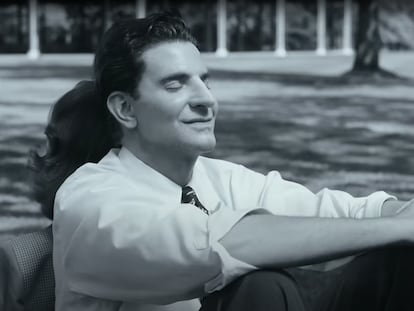Seeing and hearing Leonard Bernstein at the premiere of the film ‘Maestro’
Sony Classical releases a deluxe album of previously unpublished photographs of his best recordings as conductor of the New York Philharmonic, allowing us to delve into the protagonist of the film directed by and starring Bradley Cooper
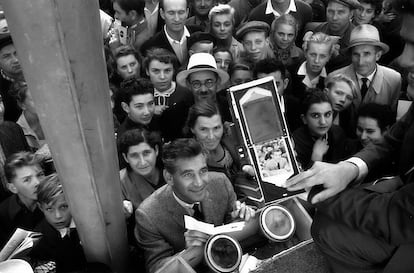

A phone call changed Leonard Bernstein’s life (1918–1990). We hear it at the beginning of the soundtrack of Maestro, the film written, directed and starring Bradley Cooper, which hit theaters this Wednesday, just a few weeks before it arrives on Netflix. It was the morning of November 14, 1943, and an emergency meant that the young Bernstein had to fill in for the legendary Bruno Walter as the conductor of the New York Philharmonic. There was no time to rehearse because the Sunday concert was scheduled for three o’clock in the afternoon. His performance would also be broadcast live on the radio throughout the country.
That afternoon could have ruined his career, but the Massachusetts-born conductor made a legendary debut. We hear his excitement illustrated by a fragment of the music he wrote for the film On the Waterfront, with the voice of Bruno Zirato, the Italian managing director of the New York orchestra. The very difficult “bop, bop, bop” that opens Robert Schumann’s Manfred overture and kicked off the famous concert, plays as well. “The audience roared like a giant animal in a zoo,” his brother Burton, who attended with their parents, later recalled.
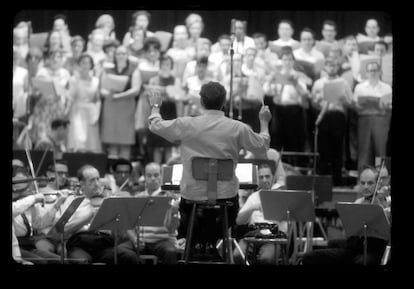
Bernstein became the first American conductor to lead a coast-to-coast telecast from Carnegie Hall. The next day, his success made the front page of The New York Times. At the time, he was a 25-year-old assistant who had composed his first symphony and a handful of popular songs. The soundtrack, just released by Deutsche Grammophon (DG), continues with his first Broadway hit, the musical On the Town. Cooper uses two of Bernstein’s songs, sung on the piano at his sister Shirley’s house, to stage his first encounter with actress Felicia Montealegre (Carey Mulligan) in February 1946. Her complex love story with the multifaceted genius of classical music, who was Jewish and bisexual, is the subject of the rest of the film.
Sony Classical has just released a coffee table book entitled Leonard Bernstein: Maestro on Record, with 224 pages full of photographs, many of which were previously unpublished. Inside the cover, there’s a compilation of his best recordings with the New York Philharmonic, from 1956 to 1975, on 12 compact discs. The release allows us to delve deeper into Maestro’s protagonist, although it only illustrates his American period, when he made countless phonographic recordings as the principal conductor of Columbia’s old New York orchestra. During the last 15 years of his life, he was linked to Europe and recorded for DG, mostly with the Vienna Philharmonic.
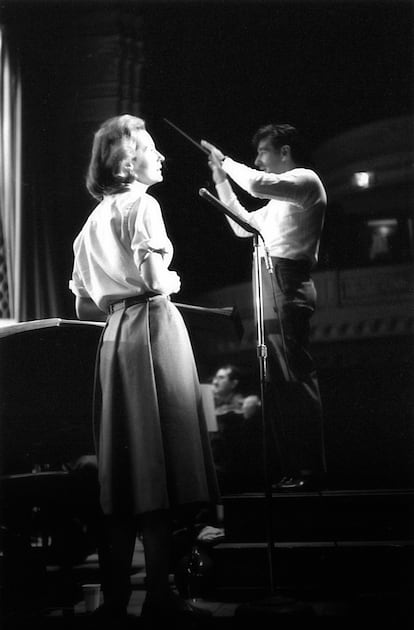
The book’s collection of snapshots comes from the Sony Music Photo Collection in New York. The archive is located in the heart of Manhattan and preserves a wealth of graphic material from 7,000 artists with the former CBS, RCA Victor, Jive and Arista labels. In Bernstein’s case, most of the photographs were taken by Don Hunstein. In chronological order, from 1956 to 1976, they depict “Bernstein’s boundless energy: preparing, performing and recording concert after concert with the New York Philharmonic, including composing and presenting the landmark Young People’s Concertos,” Craig Urquhart, Bernstein’s former personal assistant, writes in the book.
We see Bernstein with great soloists, such as pianists Glenn Gould, Rudolf Serkin, André Watts and Philippe Entremont, who writes juicy testimony about his work with Bernstein as conductor and composer. He also appears with violinists and singers, including Isaac Stern, Zino Francescatti, Jennifer Tourel, Christa Ludwig and Walter Berry. We even see him with clarinetist Benny Goodman, his assistant Seiji Ozawa and composers Aaron Copland and Dmitri Shostakovich. Finally, there is no shortage of photos of him with his wife, Felicia, touring or working on concerts and recordings of Arthur Honegger’s Jeanne d’Arc au bûcher [Joan of Arc at the Stake] and Claude Debussy’s Le Martyre de saint Sébastien [The Martyrdom of St. Sebastian], of which there’s an excerpt on CD 2.
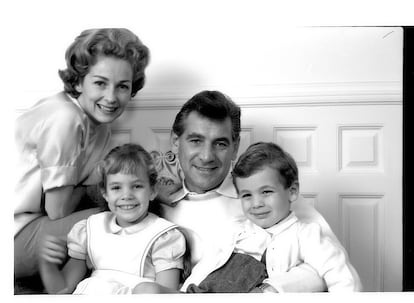
The Bernsteins’ daughter Jamie, whose memoir, Famous Father Girl, was a major source for Cooper’s film, also weighs in on the book. She speaks of the recovered snapshots as “a powerful time machine” and comments on the rudimentary technical paraphernalia of the Young People’s Concerts broadcasts. She even discovers her most unsuspected physical connection with her father: “oversized ears.”
The last testimony is signed by Gabryel Smith, head of the New York Philharmonic Archive. He reflects on Bernstein’s work in the recording studio, “one of the most intimate places to make music.” Smyth recalls the conductor’s marathon work sessions with his trusted producer, John McClure. But he also alludes to Bernstein’s scores, which the New York Philharmonic published years ago on its website: “In his notations, a chord could be enough to evoke an image, a quote, an abstract association, a struggle or a dream.”
The large-format book includes brief year-by-year commentaries that summarize the content of the photos in English and German. The first snapshots from 1956 show Bernstein conducting and playing Mozart, and the last ones, from 1976, depict the bearded conductor after he left Felicia for radio producer Tommy Cothran. In total, the photo collection includes his best recordings and the main events in his artistic career.

Standout recordings include the beginning of his integral pioneering work with Mahler’s symphonies (1960), along with several benchmarks, such as Antonin Dvořák’s New World Symphony (1962) and Igor Stravinsky’s The Rite of Spring (1958). But there are also many examples of Bernstein’s own compositions, such as The Age of Anxiety symphony (1965) and the overture to Candide (1960), which are arranged thematically on the enclosed discs. There is also plenty of commentary on the Broadway premiere of West Side Story (1957), his tour of the Soviet Union (1959) and President John F. Kennedy’s funeral and Bernstein’s tribute to him (1963).
The book contains many unforgettable Bernstein quotes, some of which are outstanding. In some, he describes himself (“Conduct, compose, piano, produce, arrange, etc. I am. all of these and none of these.” ), while in others he defines art as a mission (“It’s the artists of the world, the feelers and thinkers, who will ultimately save us”). But I am left thinking of some of the words from his tribute to Kennedy, which he surely would have repeated today: " This will be our reply to violence: to make music more intensely, more beautifully, more devotedly than ever before.”
Sign up for our weekly newsletter to get more English-language news coverage from EL PAÍS USA Edition
Tu suscripción se está usando en otro dispositivo
¿Quieres añadir otro usuario a tu suscripción?
Si continúas leyendo en este dispositivo, no se podrá leer en el otro.
FlechaTu suscripción se está usando en otro dispositivo y solo puedes acceder a EL PAÍS desde un dispositivo a la vez.
Si quieres compartir tu cuenta, cambia tu suscripción a la modalidad Premium, así podrás añadir otro usuario. Cada uno accederá con su propia cuenta de email, lo que os permitirá personalizar vuestra experiencia en EL PAÍS.
¿Tienes una suscripción de empresa? Accede aquí para contratar más cuentas.
En el caso de no saber quién está usando tu cuenta, te recomendamos cambiar tu contraseña aquí.
Si decides continuar compartiendo tu cuenta, este mensaje se mostrará en tu dispositivo y en el de la otra persona que está usando tu cuenta de forma indefinida, afectando a tu experiencia de lectura. Puedes consultar aquí los términos y condiciones de la suscripción digital.
More information
Archived In
Últimas noticias
Most viewed
- Oona Chaplin: ‘I told James Cameron that I was living in a treehouse and starting a permaculture project with a friend’
- Sinaloa Cartel war is taking its toll on Los Chapitos
- Reinhard Genzel, Nobel laureate in physics: ‘One-minute videos will never give you the truth’
- Why the price of coffee has skyrocketed: from Brazilian plantations to specialty coffee houses
- Silver prices are going crazy: This is what’s fueling the rally
